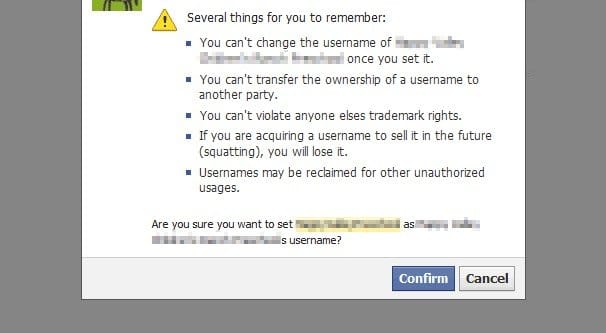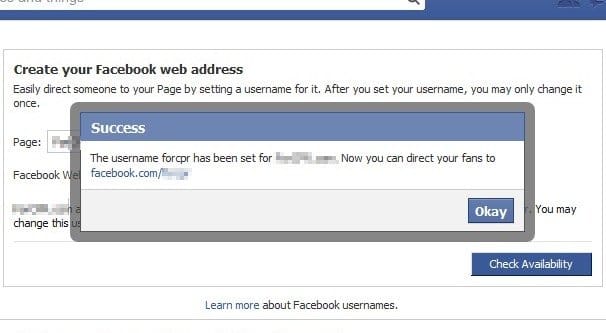 Written by ContentPowered.com
Written by ContentPowered.com
The restrictions, requirements, and guidelines surrounding Facebook page usernames – the technical name for a custom URL or vanity URL for a Facebook page – is a mess. Since pages have been around for a decade, requirements have changed a lot, and the way you do anything is liable to have changed as well.
Setting a username is actually quite easy. When you create a page for the first time, you’re presented with an admin view of that page. You have the picture, cover photo, list of tabs along the side, and a lot of different tips for filling out all of them.
Over on the left, you have the display name for your page, and a line in grey beneath it. That line says “Create Page @Username” and is a link. If you click it, a box pops up that allows you to create the username/vanity URL for your page. Facebook says “It’s easier for people to find your Page in search when it has a unique username. Pages with usernames can also create custom URLs that let people quickly visit and message them.”
You have a username box where you can put in a prospective username. This box has a 50 character limit, which his actually quite long and suitable for most any business. Additionally, as you type in a username, Facebook will automatically check to see if that name is available.
One thing to note is that just because “www.facebook.com/UsernameYouWant” is not an active page doesn’t mean you can claim it. Sometimes the page might exist but be unpublished. Sometimes it was an old page that was suspended. Additionally, if Facebook has merged that page into another page, the old URL is withheld so no one can squat it or use it to impersonate whoever had it before.
If you have set your username before, the “Create Page @Username” link will actually just be your username, and it will not be a link. Instead, hovering over it says “People can search for @username to find your Page easily. You can change your @username in the Page Info section.”
This is a bit misleading. While in many cases you will find sections like that in your settings menu, this one is actually under a tab. In the list of tabs on the left side of your page, click the About tab. There you will see the basic information about your page displayed, or prompts to enter information if you haven’t done so yet.
Up at the top is a General section, and the third entry in that section will be Username. It shows the Username you have already and an Edit button. Click the Edit button and you’ll be presented with exactly the same username prompt that you had before, when you first set the username. This is your second chance to get the username just right.
Username Restrictions
For a long time, Facebook restricted how many times you could change your page username. They required that a page had 25 or more likes in order to change the username, first and foremost.
As near as I can tell, this restriction existed primarily so that no one could squat a username. People would need to grow a page before they could take a username, so it made it harder to poach usernames from businesses who would want them.
Facebook also used to have a limit to the number of times you could change your username. Essentially, page admins had the ability to set the username once when the page was created, and were given one free change option for any page they own, though as far as I can tell that free change was only one per person, not one per page.
This combination led to various workarounds. The most common one is listed here. Basically, what you would do is find someone you trusted who you knew didn’t have a page of their own. You would add that person as an admin on your page, giving them complete – if shared – control over the page. Then you have them use their free change to change the username of your page.
This worked most of the time, but not all the time. Sometimes Facebook seemed to have caught on, and other times they let it slip through. No one knows why it sometimes didn’t work, and Facebook never said anything about it.
These days, however, you can change your username as much as you like. At least, when you’re creating a new page, you can. I have a test page I use to research things like this, with zero likes, that has never been published or visible to the public. While writing this, I tested it out, and I was able to change through five different usernames and back to the original without issue. Facebook didn’t “consume” the usernames I claimed then abandoned, and they didn’t restrict my ability to keep changing.
Facebook, my guess is, decided that it just wasn’t worth fighting people over a problem that wasn’t really a problem. If someone wanted to squat a URL they could have botted up the likes easily enough, and all the restriction did was limit the ability for real users to match their URL and their brand.
Now, there is still a restriction on the display name of your page. When you want to change that, you have to submit a request to Facebook, and they have to approve it. URL is apparently less valuable to Facebook users than display name.
If you’re having other issues with setting a username, you might be running into one of the actual username guidelines.
- You can only have one username for your page. There’s no way to have two different usernames direct to your one page, unless you use a goofy workaround with creating a second page and merging the two through the official Facebook merge pages process.
- You cannot claim a username that someone else already has. Unfortunately, usernames are shared across both profiles and pages. If your brand name is BrandName but someone has their personal profile name set to BrandName, you won’t be able to claim it. You could try to file a trademark dispute, and you might win if the user’s name isn’t actually Brand, but you might also lose if it’s their real name.
- Usernames can only use letters, numbers, and periods. No dashes, no underscores, no slashes, no parentheses, and no special symbols. This even applies to pages created in countries with non-English letters. A page like this one, representing a Japanese location and aimed at Japanese people, still has to have a username made out of English letters.
- Additionally, any capitalization doesn’t actually matter as far as the URL is concerned. To use Facebook’s example, johnsmith, JohnSmith, and john.smith all count as the same username. You could even use J.o.H.n.S.m.I.t.H. if you really wanted, though at that point you’re really sacrificing human readability for some nebulous idea of URL fashion.
- Usernames have a filtered word list that you can’t use. Most curse words are filtered – though Hell isn’t, if you’re interested – and any hateful term for a group of people is generally banned as well. The filter isn’t too precise, though; testing various words and phrases, “goaway” is filtered for containing words that aren’t allowed on Facebook, but if I add a noun of any sort to the end of it, suddenly it works.
- Usernames are also not allowed to have domain extensions or “generic terms” in them. For example, I can’t have @computer as a username, nor could I have brandname.com as a username. Interestingly, Facebook has not kept up on new TLDs. I could have brandname.io, brandname.site, or brandname.photo if I wanted.
And, of course, Facebook isn’t going to bend the rules for anyone. If you want a username that doesn’t work, you’re out of luck. You’ll have to find a different one. The only way you can get hold of a username that isn’t valid is if the username is your trademark and is in use by someone else who doesn’t have valid claim to the trademark. That’s pretty much it.
Facebook Page Display Names
The display name of the page is not involved in the URL, but rather, is the name people see when they go to your page. For example, https://www.facebook.com/pcgamermagazine/ is a URL that leads to the PC Gamer page; the username is PCGamerMagazine but the display name is just PC Gamer.
Display names are harder to change because they’re the more visible representation of the brand. They still have to be unique, and many of the same guidelines exist. You can’t use hate speech or a term that violates the rights of anyone. You can’t use symbols or unnecessary punctuation. You CAN use non-English characters, as in the Japanese example I gave above. You can’t use the word Facebook, and if you use generic words like “pizza” it has to be part of a brand name. “Domino’s Pizza” works, but not just Pizza.
Additionally, as I mentioned, you can only change the display name if the new name still accurately represents your brand, and you can only change it by request, which means someone at Facebook has to manually process the change request.
You do have to be Admin to request a page name change, and you can’t change the name of a page that is just a regional page that is part of a global franchise. This is an edge case that comes up occasionally and is meant to smooth out variance in naming between franchise locations.
Ease of Use
This, and a few other changes I’ve written articles about, are just more streamlining elements Facebook has been rolling out for a few years now. I for one very much appreciate them.
When you have to cope with something like 25 likes to change a username or the ads-based 20% text rule, it makes Facebook marketing an exceptionally frustrating experience. It’s just a system full of nonsensical “gotcha” moments that don’t add anything to the experience. They cause no end of trouble and end up with hundreds of people posting in the Facebook support center asking why they can’t set a new username or why a perfectly fine advertisement isn’t approved.
I’m pretty glad Facebook seems to be stepping back from a lot of these “gotcha” moments. Frankly, most of them didn’t actually stop the kinds of things they’re supposed to stop. It was a lot more likely that a small brand starting a Facebook page would have trouble with the username than it was a spammer or squatter. Plus, with a basic like requirement, it turned a lot more people to techniques Facebook would prefer to squash, like buying fake likes or creating dummy accounts just to round out that number. It’s really not that hard to make up information for 25 people and have each account follow your page. You could worry about actual growth later.
At the end of the day, it’s a good thing that Facebook is working to streamline, smooth out, and remove the hassles from managing pages on their platform. It helps them retain new users, it makes the learning curve easier, and it lets you get past the minor details and into real marketing that much faster.








Paul
says:Great post! thanks. So, i think you’re saying i can’t use my personal page name (my name) as my username on my page. is that correct?